This page contains affiliate links. I’m part of the lululemon collective and will receive a commission if you make a purchase through the links below. As an Amazon Associate, I earn from qualifying purchases. Read the full disclosure here.
If there’s anything the pandemic taught us, it’s how to recreate our favorite things at home.
Going to the yoga studio is a full sensory experience, from a live instructor and personalized guidance to a quiet zen-like environment with soft lighting (and a reason to not check your phone for an hour).
However, taking time out to get to a class can be time-consuming and add additional stress to an already hectic schedule. Not to mention, it can be expensive.
If it’s a choice between home yoga or no yoga, there are plenty of ways to bring the studio to you.
This article will take you through everything you need to know to set up your home yoga studio, even as a total beginner!
Disclaimer: This content is for educational purposes and is not medical advice. Read the full disclaimer.
Pros and cons of home yoga
First, let’s talk about the pros and cons of a home yoga practice. Everything has a trade-off, and it’s essential to know the facts to make the best decision for you.
Keep in mind that someone’s pros might be your cons, so these are just some examples to consider.
Let’s dive into the pros.
First of all, home yoga is inexpensive. It can range from free to a small fee per month to access online classes.
With so many options on demand, you can practice any time that suits your schedule. It’s also easy to do yoga in a small space and it requires minimal equipment.
A home practice allows you to relax by yourself, so if you’re not into attention from a yoga teacher or have anxiety about doing yoga in front of others, a home yoga practice might help ease some of those fears.
Now onto the cons.
A studio class allows you to receive feedback from the yoga instructor on your form, which can help with injury prevention and learning new ways to make poses comfortable in your body.
If the studio has mirrors, you can also receive visual feedback to gauge your practice. Yoga teachers are also typically available to answer questions before or after class.
It can be challenging to “turn your brain off” at home or find the motivation to dive deep into your practice. You also might struggle with frequent interruptions from family members or noisy neighbors, making it difficult to tune out the mental chatter.
A home practice lacks a community feeling. If your yoga journey is synonymous with social interactions and meeting new people, a home practice may feel more isolating.
Practicing on your own also can lead to a lack of variety or exposure to new yoga styles.
How to set up a home yoga studio for beginners
Here are some easy tips to successfully start your home yoga journey.
Schedule your time
Make your home yoga practice a priority by scheduling your time as if you were going to a class. Actually, it is a class. It’s just your class!
Some apps even allow you to schedule classes and receive reminders on your phone.
Your yoga time is just as important, even if it’s at home. If you don’t have a lot of time or are new to yoga, try a short 10-15 minute practice. Even small doses of yoga have big benefits.
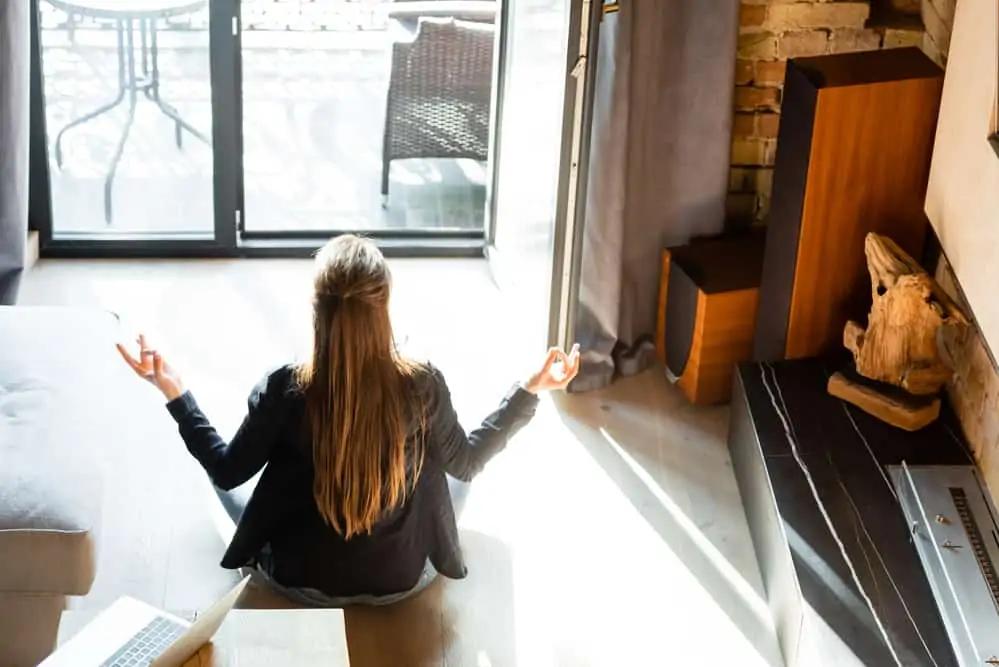
Building your home yoga studio
Depending on your home environment, finding a quiet, distraction-free space can be challenging.
While most people don’t have the option for an entire “yoga room,” you can still create an inviting space that your senses will crave. Perhaps you have a quiet corner or a window with a view. Aim to minimize distractions.
If there are other people in your house, consider a separate room where you can close the door to remind others to respect your space. (Including adorable cats and dogs that think you’re on the floor to play with them.)
Your home yoga space should be peaceful and clutter-free to ease mental distractions. Decorate your space in a way that makes you feel calm and grounded. There’s no wrong answer!
Jazz up your space with some plants, candles, or an essential oil diffuser to create a relaxing environment. Pinterest has no shortage of inspirational home yoga spaces to get your creative juices flowing.
Music can also be a powerful addition to your home yoga studio.
You can find yoga playlists on Amazon Music, Spotify, YouTube, and Soundcloud to help set the mood for your space. Many albums and playlists are available with free plans.
Everyone has different preferences when it comes to music. I’m a fan of ambient instrumental music. I find it helps drown out random background noise and helps me focus. Others like chill beats or even pop music. It’s all up to you.
Try different styles of yoga
There are many different styles of yoga ranging from high-energy Vinyasa and power yoga, to quiet and calming restorative practices. Contrary to popular belief, you don’t need to be flexible to do yoga. Yoga is accessible and adaptable for any fitness level.
Experiment with different styles of yoga to find the practice(s) that work best for you. Slower yoga styles, such as Hatha yoga, slow flow Vinyasa, and restorative can be very approachable for beginners.
You can also match your practice to how you’re feeling today. If you’re in need of rest, try restorative yoga, yin yoga, or yoga nidra. If you have lots of energy to burn, a Vinyasa class might match your vibe.
Home yoga studio essentials
If you’re serious about starting a home practice, props are a fantastic investment.
These items are not expensive, especially if you’re comparing the money you will save from not going to studio classes to the one-time price of some good-quality props.
You can also bring props with you to gym or studio classes. Props are not always available, depending on the venue, to it’s convenient to have your own.
A good quality yoga mat
If it’s in your budget, look for a quality mat from the start. A great mat can make a significant difference in how you move and feel during your practice.
You can get an inexpensive mat, but if you’re not happy with it, $30 is a waste of money. Put that toward a quality mat you will look forward to using.
Here are some high-quality mats that will last for years:
For a more in-depth review of some of these mats, check out Outstanding Yoga Mats For Sweaty Hands.
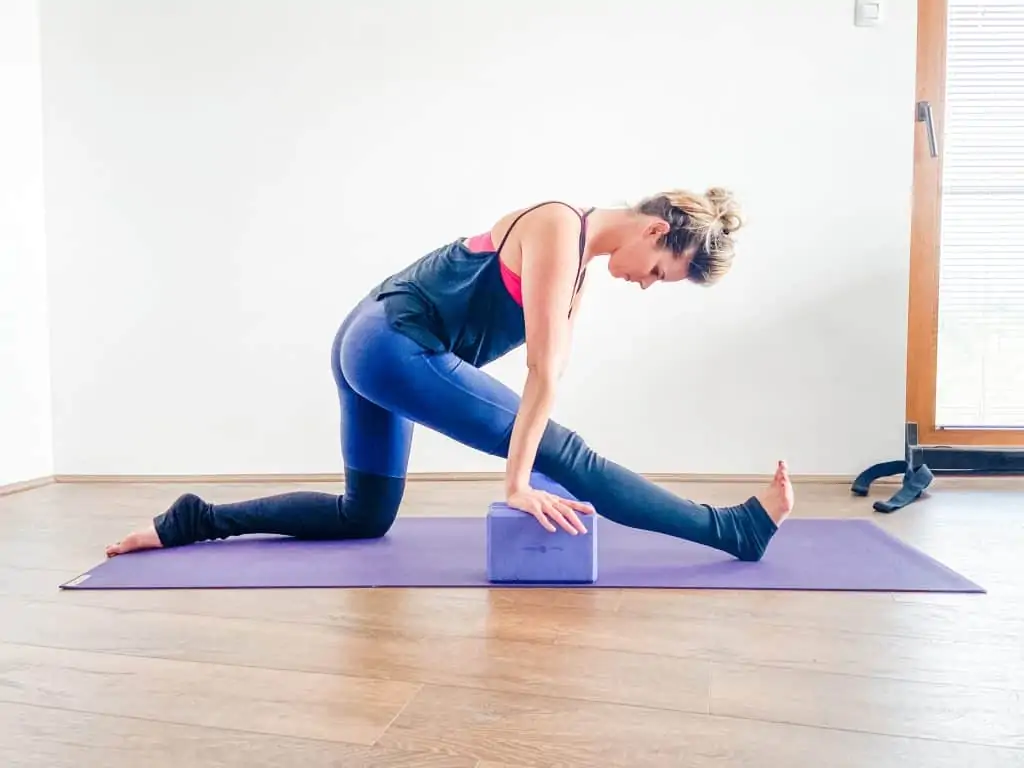
Yoga blocks
Such a simple piece of foam (or cork) provides endless options to support, deepen, and add dimension to any practice from beginner to advanced.
A yoga block can bring the floor to you and create more space to tailor poses to what feels good in your body.
Best yoga blocks:
- Best foam block: Hugger Mugger Foam Yoga Block
- Best budget foam blocks (set of 2): Clever Yoga Foam Block Set
- Best cork yoga blocks: Jade cork yoga block
- Best wooden yoga blocks: Hugger Mugger bamboo yoga block
- Best ergonomic yoga block: Manduka unBLOK
Related Read: How To Use Yoga Blocks To Prevent Injuries
Yoga strap
A yoga strap can help you extend your reach and can be a real lifesaver for sensitive tissues.
When you can reach further without compromising form, there will be less strain and range of motion required from your knees (and other joints), allowing you to adapt any pose to your comfort level.
You can easily improvise at home with a dog leash, soft belt, small towel, etc.
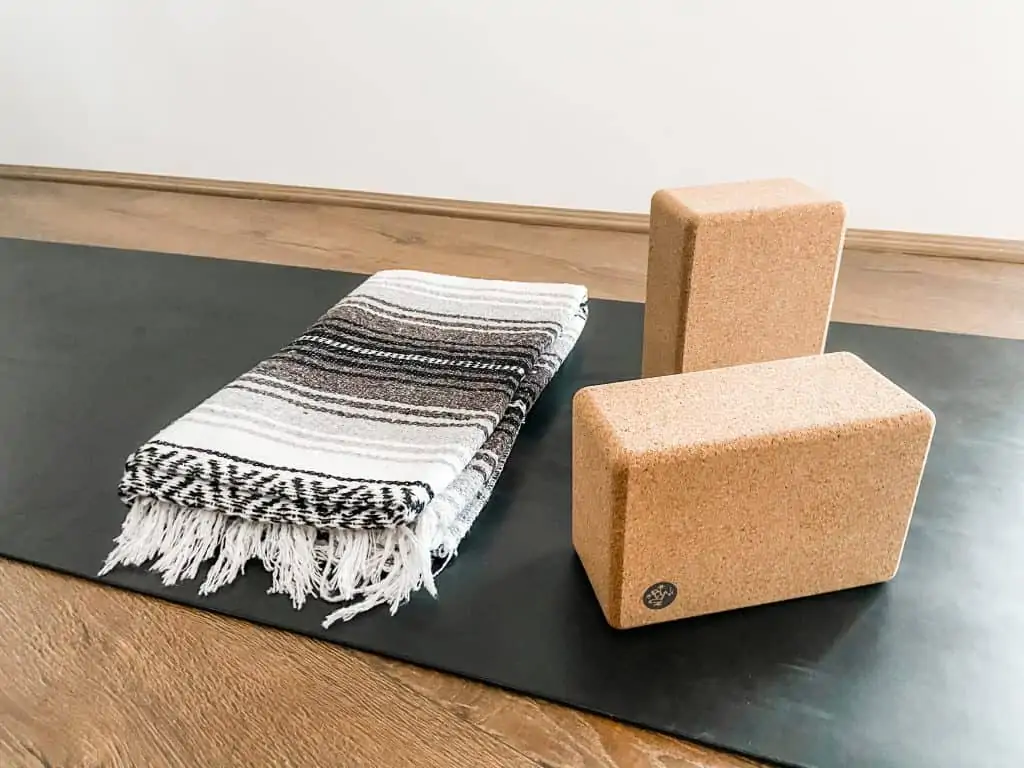
Yoga blanket
A blanket is another versatile prop that can be folded or rolled in various ways to provide the support you need.
A yoga blanket has a suitable thickness and weight to provide cushioning for many different poses, including kneeling poses.
Blankets are inexpensive and a great addition to any yoga practice. If you don’t want to buy too many yoga props, a blanket is multifunctional.
You can also use any large towel at home to serve the same purpose.
Bolsters & cushions
Bolsters are tremendously helpful to support the body for restorative practices or props during Savasana. Seated cushions are another option to lift the hips for seated postures or meditation.
The filling for these props is made from a variety of materials that vary by brand from synthetic, recycled, or natural materials like buckwheat. The filling material may determine the level of support.
Blankets and bolsters are essential for any restorative yoga or yin yoga practice. Pillows can substitute for bolsters at home.
Home yoga class options
Yoga classes are an easy way to practice without having to come up with your own sequence or routine. There are many options (both free and paid) available for home yoga classes on your time.
Many of these paid options offer a generous free trial period so you can confidently decide which app is right for you.
YouTube
If you’re looking for cheap and cheerful (and by cheap and cheerful, I mean free), YouTube is where it’s at.
You can find any type of yoga, from beginner to advanced. There are many channels and instructors to choose from to pick who vibes with you. Yoga class options range from less than 10 minutes to full-length 60+ min classes.
The obvious pros of YouTube are that it’s free with loads of content. On the flip side, this might be too much choice. You also have to deal with ads, can’t schedule classes, and can’t download for offline use (at least with a free subscription). If your wifi is a little spotty, this might mess with your flow.
Here are some favorites with plenty of content to get you started!
Yoga Download
If you’re looking for an affordable paid app for all levels, check out Yoga Download. With Yoga Download, you get access to over 1700 yoga classes for all levels, with new content added weekly.
They have an easy-to-follow menu with lots of options for beginners. Choose a class by yoga style, length, instructor, focus/goal, and more. Yoga Download offers programs and challenges with different themes to get you in the habit of a regular yoga practice.
There are helpful resources for beginners, including a guide to all different yoga styles, a pose guide (which you don’t need a membership to access), and workshops for technique.
Yoga Download offers a 2-week trial for $1. Pricing (at the time this article was written) is $10/mo for an annual plan and $18/mo for a month to month. They also have some free content on their YouTube channel.
They allow unlimited streaming and free downloads. I know this sounds silly, but I’ve paid for fitness apps before, where downloading content costs extra on top of the streaming service! (BTW, not cool!) So if you travel a lot or your wifi is spotty, you’ll still be able to access your content. (Whew!)
Yoga International
Yoga International is another popular streaming service with access to both live and on-demand classes. Their total library is over 1900 classes.
Within the library, you can filter classes by level, length, instructor, style, and more. Programs and challenges, as well as Pilates classes, are also available.
Yoga International offers a 30 day free trial period, which is more generous than the average 7-14 day free trial period that most yoga and fitness platforms provide.
The monthly price is a bit more expensive at $19/mo. However, they do run deals on their pricing if you sign up for an annual subscription. The price per month is about equal to the price of just one studio class.
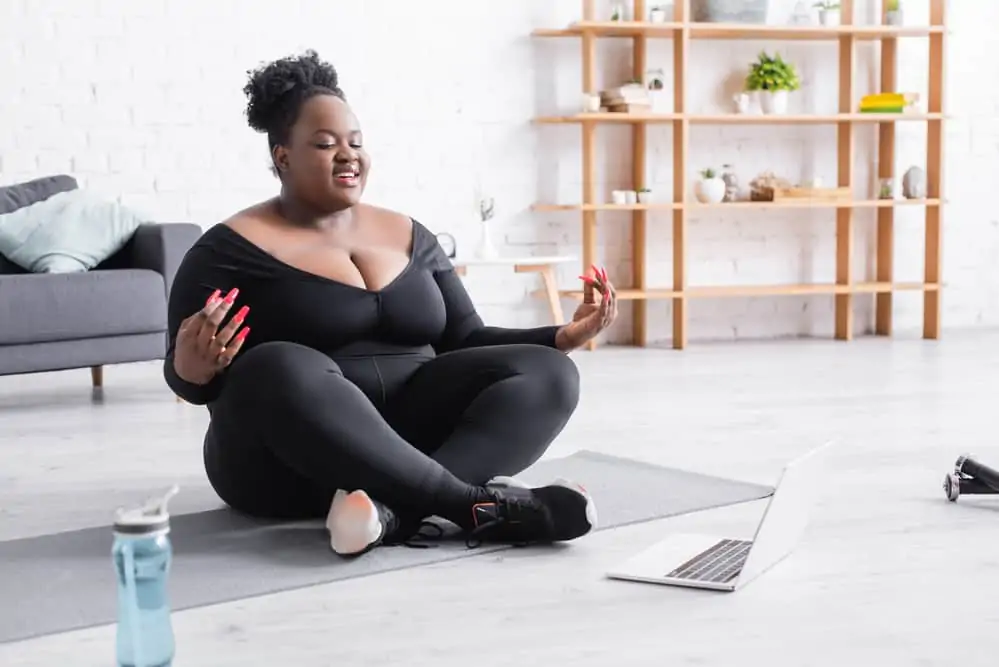
ALO moves
ALO Moves has yoga classes for all levels and includes fitness classes ranging from Pilates and barre to HIIT and strength training. They also offer mindfulness classes including yoga nidra, meditation, and breathwork, as well as a skills section to learn the technical aspects of advancing your physical practice.
With a wide variety of offerings, ALO Moves is also more of an all-in-one yoga and fitness suite. There is a mobile app to access classes on the go.
The classes on ALO have that clean and trendy boutique-style look and feel.
Alo Moves gives a 14-day free trial to get out the offerings on this service. After the free trial period, the service is $20/mo or $199/yr.
This is one of the more pricey options, however, they do offer yoga and fitness to cover all your bases. Not to mention, a typical studio class runs from $15-25 per class, $20/mo sounds like a steal in comparison.
Aaptiv
Aaptiv is more of an all-in-one fitness option with guided audio classes. They offer yoga classes, which might be a good option if you’re looking to limit your number of paid apps.
Because let’s be honest, when everything is only $9.99, costs add up pretty fast!
If you’re looking for yoga plus other workout classes, Aaptiv is worth a look. Get access to a 30 day free trial here.
Read my full review of Aaptiv to decide if this all is right for you.
Getting to know yoga poses
If you’re a beginner, tons of new lingo can be overwhelming, especially when you’ve been told yoga is excellent for relaxation!
Many beginners are so focused on keeping up with the class that they miss the benefits of connecting to the breath and absorbing the moment’s sensations.
It’s ok to skip a yoga pose or take your time moving in and out of postures. It’s even acceptable to take a child’s pose and rejoin the class when you’re ready.
One of the drawbacks of a home practice is that you won’t receive feedback on your form. Get to know some basic poses and tips for injury prevention with this free guide featuring an in-depth look at 10 yoga poses for beginners.
You can also just take some time to watch a few YouTube videos of short beginner practices familiarize yourself with the form and names of poses before practicing.
Keep in mind that there’s always a way to modify a pose and make it more comfortable in your body.
They type of yoga you choose also matters. Slower yoga styles, such as Hatha yoga or slow flow vinyasa, can be better suited toward beginners.
Yoga poses for beginners
Here are three poses to get you started. I’ve also included the Sanskrit name that you also may hear in different practices.
For more ideas on variations of these poses and others, grab the free guide!
Child’s pose
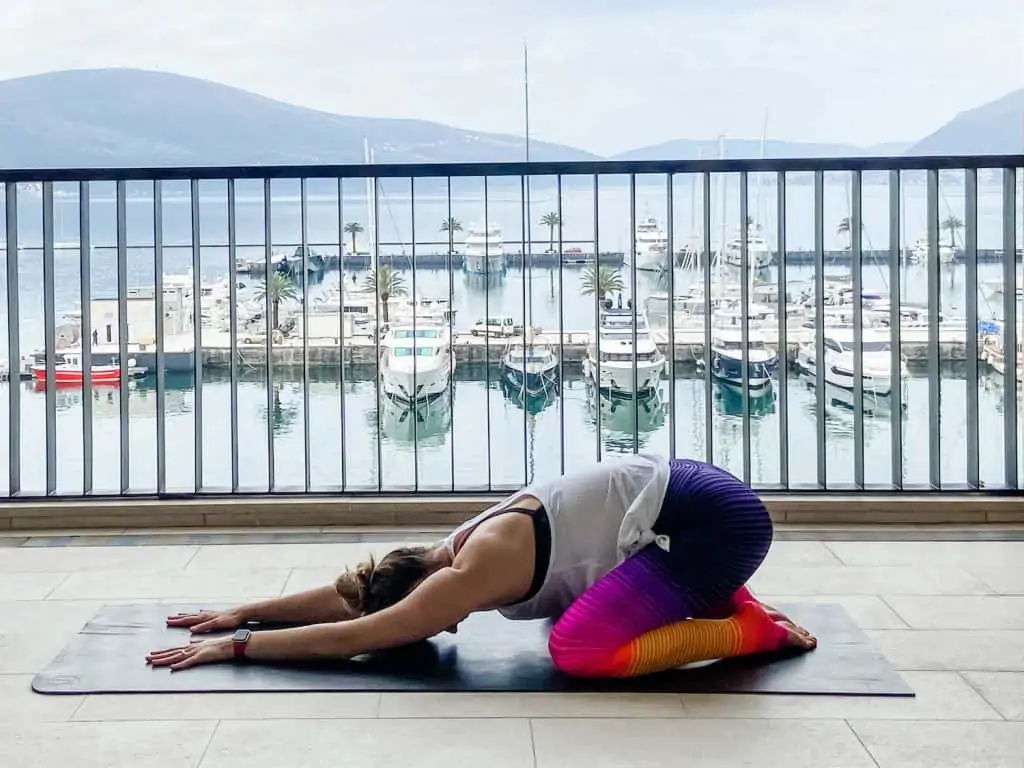
Child’s pose (balasana) is a must-know calming resting pose. Feel free to take this pose at any time on or off the mat, no matter what the rest of the class is doing.
Other benefits include lengthening and stretching for the spine, relaxation for the neck and shoulders, a calming reset for the nervous system, and gentle stretching for the hips.
Form tips
- Sit back on your heels and lower your head down to the mat.
- Hands can be resting on the mat, reaching toward the front of the mat, or down by your sides.
Variations
- Widening the knees
- Placing a bolster under the chest and belly for a supported child’s pose
- Placing a blanket under the hips for knee discomfort
- Taking the arms down to the sides
Downward facing dog
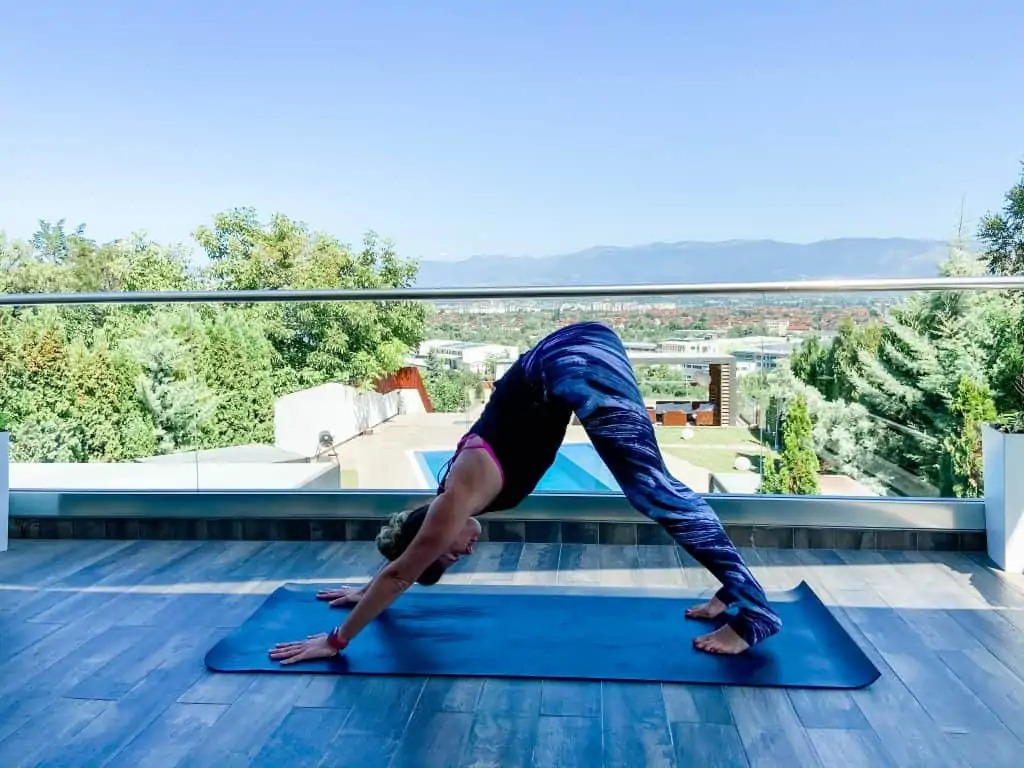
Downward facing dog (adho mukha svanasana), is a pose used frequently in yoga classes. It can be used on its own or as a transition to other poses.
Downward dog provides both flexibility and strength benefits. It is also considered an inversion (when the head is below the heart) and can be calming after other strenuous poses.
Downward dog provides strengthening for the shoulders and upper body as well as helps to elongate the spine.
Form tips
- Working from the ground up, spread the weight through all ten fingers to take some pressure off of the wrists.
- Turn the insides of the elbows toward the top of the mat to align the shoulders. This creates more space at the shoulder joint and can help avoid rotator cuff impingement.
- Send your tailbone high. It may help to bend the knees deeply. The heels don’t need to touch the ground.
- Relax the head and neck, the ears should be in line with the biceps on the upper arm.
Variations
- Bending the knees and bringing the chest closer to the thighs can help deepen the pose if the hamstrings are tight.
- Placing yoga blocks under the hands can also help with hamstring tightness and bring some additional space for advancing the legs to the tops of the mat during transitions.
- You can always substitute with a tabletop pose if downward facing dog is not for you today. Hanging the head down can be uncomfortable with congestion, for example, during allergy season.
Warrior 2
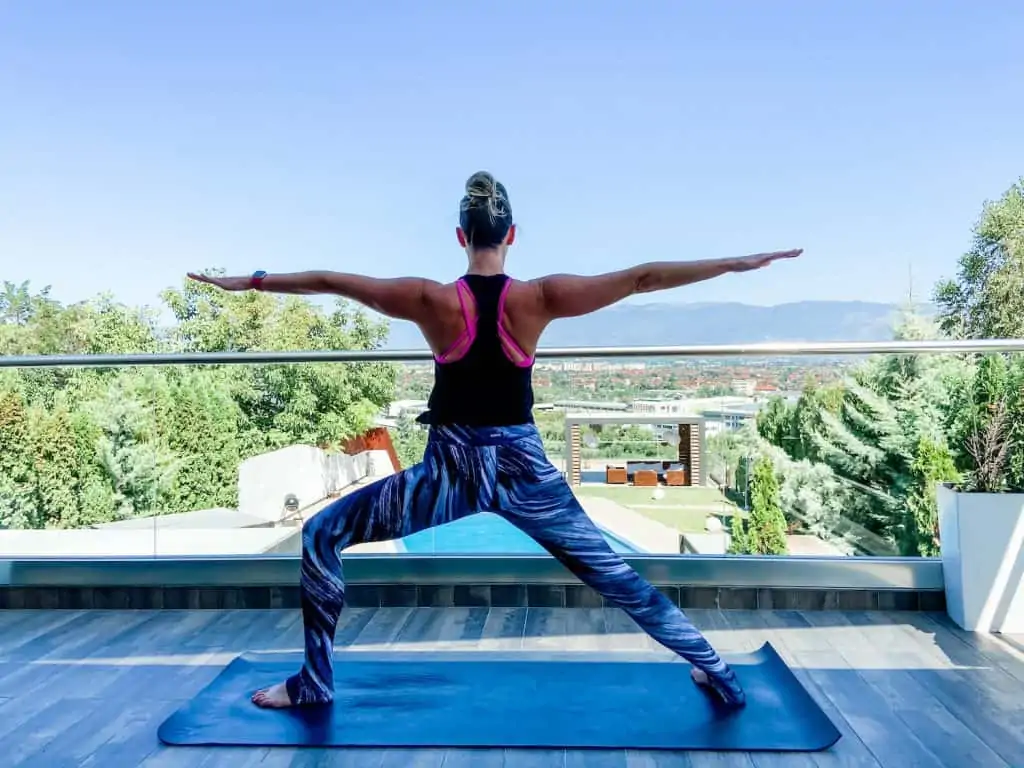
Warrior 2 (virabhadrasana 2) is a standing pose and the hips are more open (into external rotation on both sides) as the back foot is positioned (approximately) parallel to the short edge of the mat and the pelvis opens toward the long side of the mat.
Benefits of warrior 2 include strengthening the legs and other postural muscles, opening the hips, and balance/stability. Warrior 2 can also be both a grounding pose and an energizing pose.
Form tips
- The front knee should be stacked over the ankle.
- The back leg should be straight with the foot either parallel to the back (short edge) of the mat or toes slightly turned in for hip comfort.
- Be careful not to compromise the alignment of the front knee. Only turn the pelvis as far as your hips will allow you comfortably to maintain proper alignment.
- Arms can be held at shoulder height, engaging the upper back muscles.
- Avoid arching the low back.
Variations
- Adjust the distance between your feet. Shortening the stance can help with balance and hip/SI joint comfort.
- Turning the back toes slightly in can offer a different sensation.
- Arms can be held in a cactus position or down to accommodate for any shoulder pain.
Are you ready to get on the mat?
Yoga has many benefits to support healthy, active lifestyles. Not going to a studio doesn’t mean you have to miss out.
Even if you love the studio, home yoga can be an easy way to supplement your routine. Use these suggestions to build your home yoga practice, and start enjoying the benefits of yoga today!
Let me know how it goes!
You might also like:

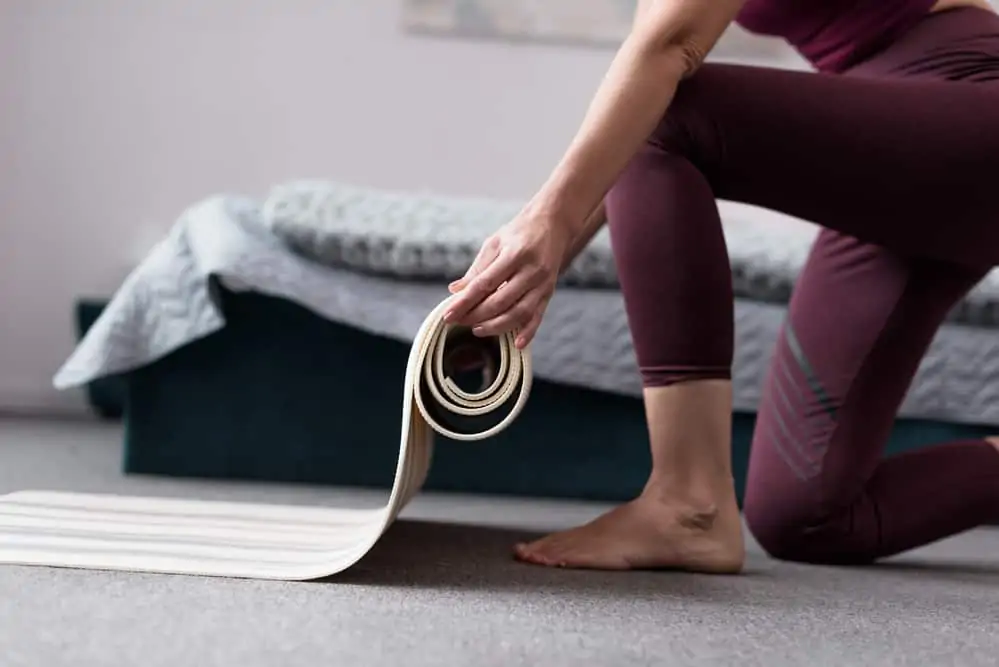
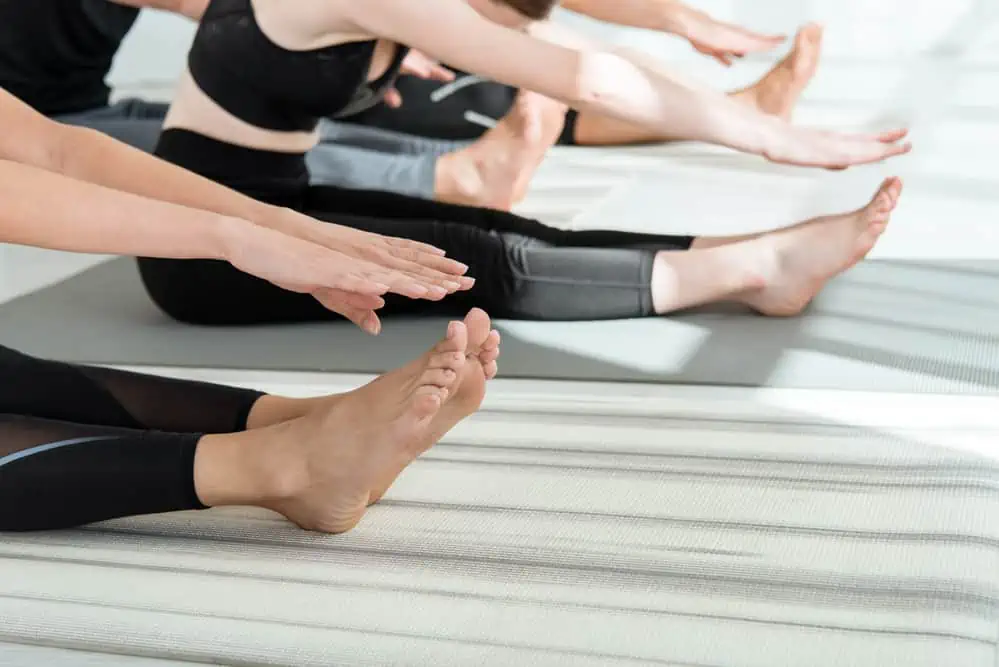
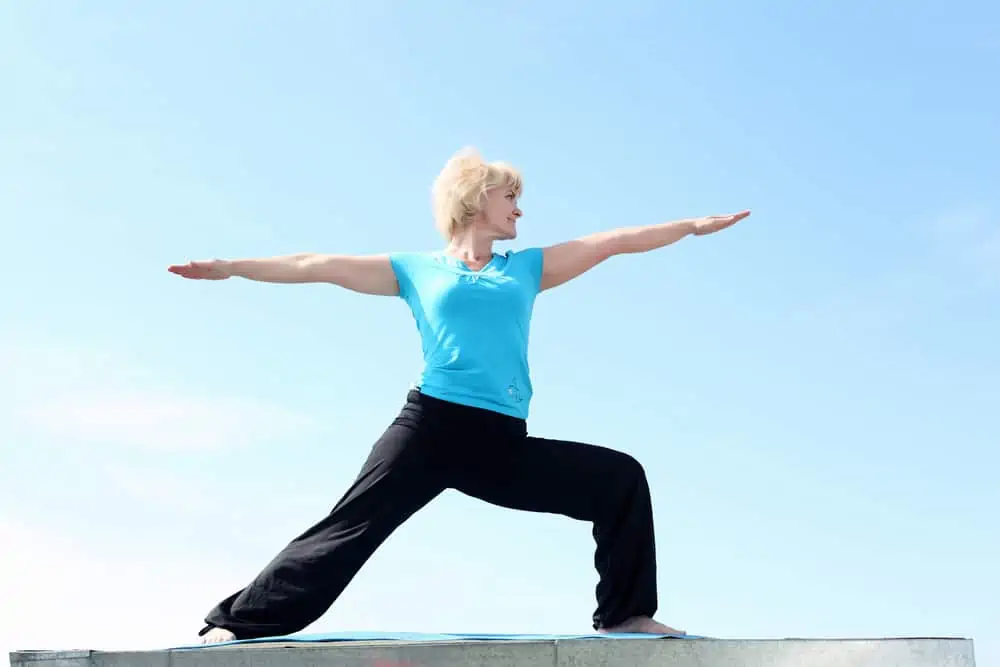
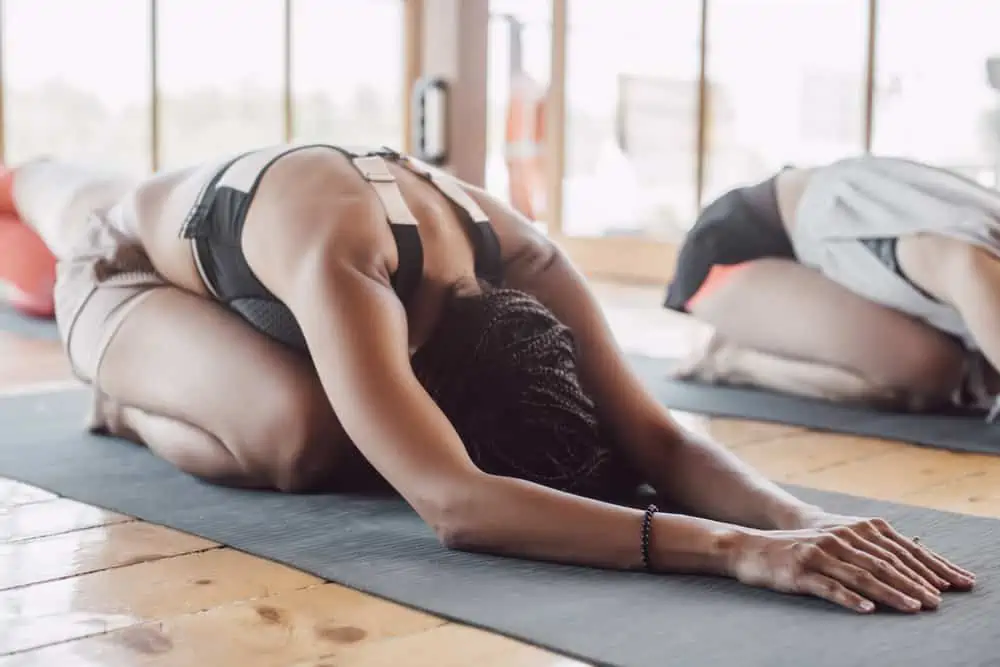

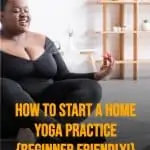
I think you’re right, there are both benefits and cons to both at home and going to a yoga class. Even though I’m an introvert (and like being alone), when I’m at home my mind races as to all the chores I “should” be doing, instead of relaxing as I do when I go to a studio class. BUT, I should give home yoga another try!
I never used to be able to do yoga at home as I much prefer the studio, but after going through my 200-hour teacher training, I appreciate the accessibility more and am able to enjoy it. I agree, I find it very distracting at home sometimes! I would also say the pandemic helped me commit to more home yoga! Thank you for reading.
Wow, such an amazing in-depth article for a beginner to yoga. Was really pleasant reading it to the end.
Thank you for reading, I’m glad you found it helpful.
About a year ago I started adding flow yoga to my exercise routine to help relieve stress and ease my tight muscles. It is a practice that I truly enjoy!
Yes! It has so many wonderful benefits and there’s a yoga style for everyone. Thanks for reading!
Very insightful read! I started doing yoga at home after the onset of the pandemic. At first, I found it challenging to commit and make time for it, but then I started waking up earlier and do it first thing in the morning. It worked, and yoga is a great way to start the day. Thank you for sharing.
Thank you. I think the pandemic encouraged us to try things at home!